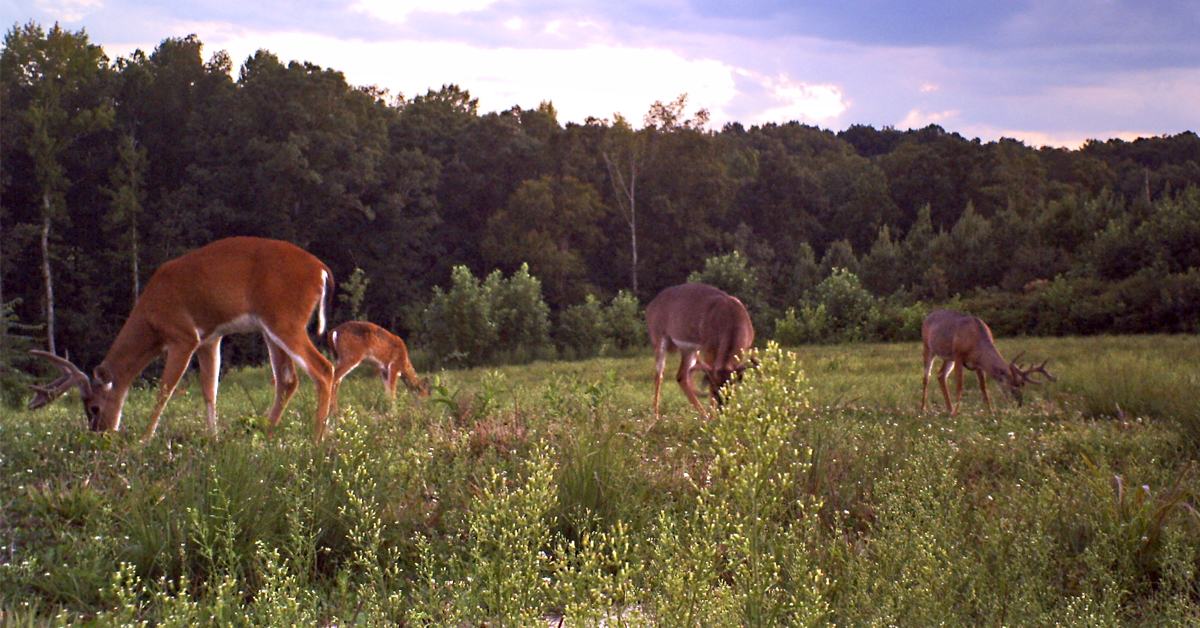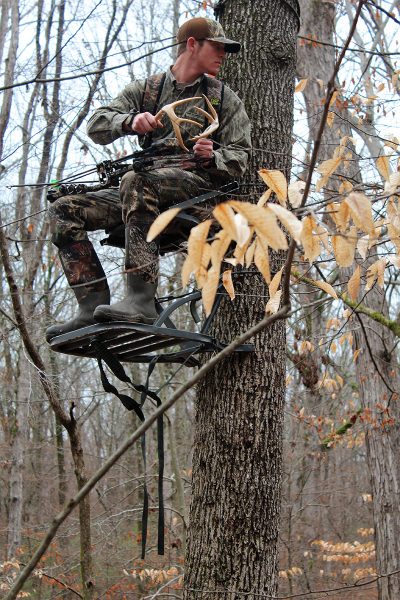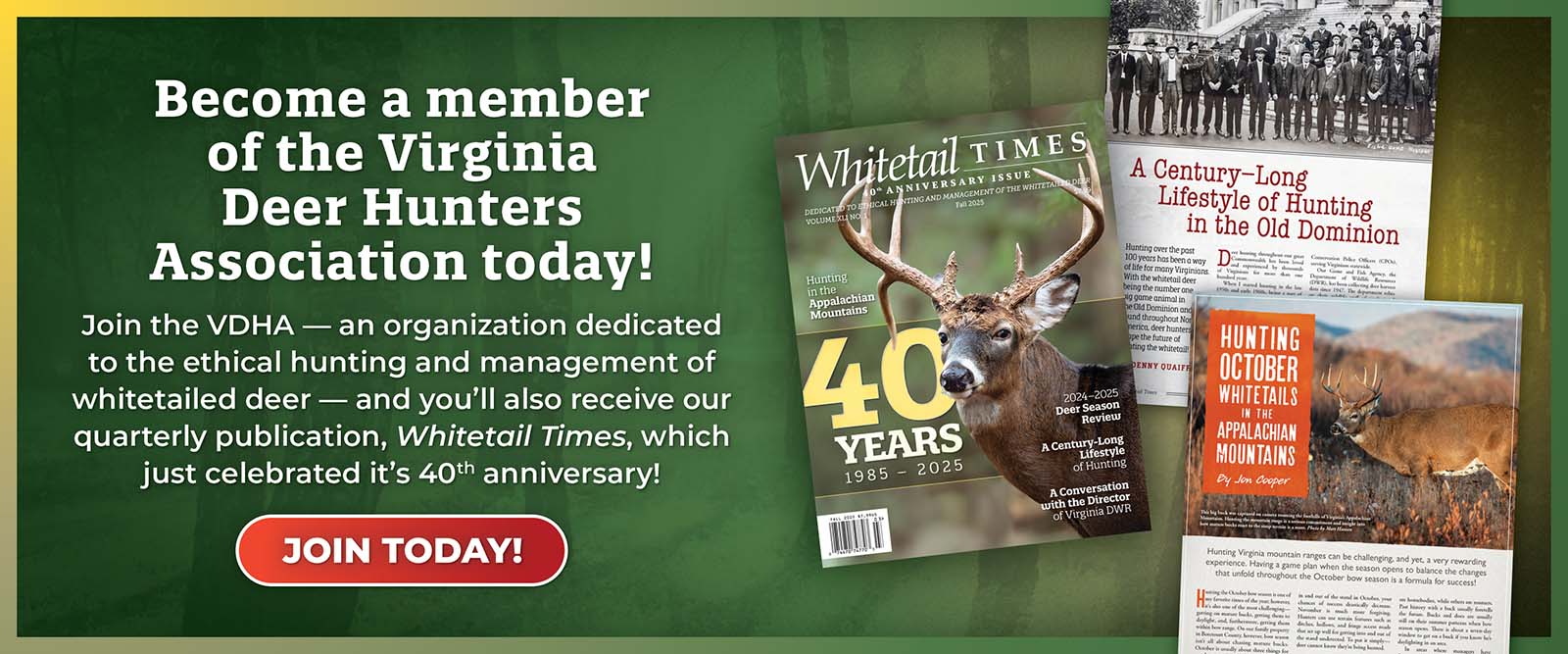
Deer will frequent food plots that have become a big part of Quality Deer Management. Food is a primary factor surrounding deer behavior! Photo courtesy of Denny Quaiff
By Matt Green for Whitetail Times
A cold December breeze drifted through the open hardwoods as I slipped into my favorite stand on a small local farm. Experience taught me that this was the two-week period I anticipated seeing bucks prowling for receptive does. Of all the ways to predict the timing of the rut, I trusted most the deer behavior I’d witnessed in the past. By 9 a.m., I was second-guessing myself, having only been entertained by foraging squirrels. Just past 9, a deer, likely a doe, more than hurried through the woods behind me about 100 yards. She wasn’t out for morning exercise; something was chasing her. Minutes later a six-point responded to my grunt call, and his curiosity helped him become my first harvest with a handgun.
Why did I choose this stand site? Why such optimism at this time of year? What about the deer? How might his experience have influenced his behavior? Countless articles, and books have been written in effort to understand animal and human behavior. Although deer behavior often proves unpredictable, some basic concepts from beginning psychology can help hunters more effectively understand behavior—ours as well as the deer’s. This, of course, can be an advantage come fall.
In a nutshell, psychology is the study or science of mental processes and consequent behavior. A prime example is Pavlov’s experiments with canines where a response (salivation) was linked with external input (sight of food). Likewise, positive and negative reinforcement can influence behavior. How can these ideas help us convince that 150-class buck of a lifetime to enter downwind, and pose like a postcard in our shooting lane? That’s wishful thinking. However, understanding psychological factors that affect whitetail behavior is a step toward thinking like a deer, which can help us be in the right spot at the right time during the season.
Terminology
Initially, a few definitions are in order. Association means to form a link between two items, generally through experience. We associate December with cold weather (not so below the equator). A reinforcer is a stimulus, possibly a reward that strengthens a desired response. Positive reinforcement is the addition of a pleasurable stimulus to a desired behavior and negative reinforcement is the removal of an unpleasurable stimulus because of some behavior. Intermittent reinforcement is a pattern in which the stimulus is applied at random (vs. predictable) intervals. Three primary factors dictate deer movement/behavior: a) food, b) breeding and c) safety/cover. Let’s examine how deer behavior might be linked to these three components and the role of association and reinforcement.
Food
Food can be a primary determinant of deer behavior. When deer find a green field or a mature oak dropping plentiful acorns, they associate this location with eating. The link between that location and eating is an example of positive reinforcement. The behavior of arriving at that site results in a meal. Frequent visits by deer may prompt the name “honey hole,” as the hunter associates that stand site with success. This helps explain why hunters are often interested in the quality of the mast crop each year.
While presence of acorns reinforces mealtime, that link can be disrupted. If a deer senses the presence of danger (human, coyote) they will depart or avoid the site regardless of hunger as they associate predator presence with danger, which trumps food on the pecking order. Older deer, especially wary bucks, may take that to the extreme. If they sense human presence even once, they may vacate that location for extended periods. This is the reason seasoned hunters are exceptionally careful to hunt prime stands only when the wind allows. If evidence of a predator is always present, it is possible deer become conditioned to accept some level of danger or the association is weakened. More on that idea later.
Breeding
In addition to food, breeding ranks among the top factors driving behavior. Most hunters are aware of that highly active time of the season when even older bucks seem way less cautious. The rut is influenced by hormones and other factors likely unrelated to previous experience. Built-in mechanisms urge whitetails to diligently seek out opportunities to breed, often at the expense of their safety. However, a buck’s behavior during the rut is likely influenced by experience as well. What does a buck associate with breeding? The obvious answer is a doe. But bucks also associate breeding (and the doe) with estrous scent as well as doe bleats and the rattling of horns announcing an argument between two other bucks competing for a doe.
When a curious buck arrives to investigate the sound of rattling horns, he may be “in the running” for rights to a doe. If success occurs at unpredictable intervals (i.e. sometimes the does is receptive, other times not), then this behavior is intermittently reinforced. This is an extremely strong reinforcement pattern.

Mature bucks are attracted to the sound of sparring because they associate this sound with competition for a doe. This explains why some hunters experience success with rattling. However, poor buck to doe ratios work against the hunter, as bucks are conditioned to stay near a hot doe rather than roll the dice and follow the rattling. Photo by the author
Experts suggest the ideal for situation for rattling success is a 1:1 buck-to-doe ratio. Why? That sets up greater competition for breeding rights. Suppose there are five, or even 10, does per buck. Each buck may have his pick and is unlikely to abandon an estrous doe on the chance he might encounter a receptive doe. Not a bet he’s usually willing to take—a bird in the hand is worth two in the bush.
The Senses
A buck may link certain sights, scents and sounds with the presence of does and therefore breeding opportunities. Consequently, decoys, urine placement, bleats and rattling can be successful approaches for drawing in anxious bucks. What’s the behavior link? A buck smells a doe and follows her scent trail (a behavior). Often the buck encounters the doe. If receptive, the brief relationship may prove positive for the buck, which reinforces the link between scent and breeding.
Fooling a buck with decoys, urine, and rattling is never fool-proof, but, like other approaches, it can be effective. An alternate technique many hunters may use is to simply hunt near the does, which are guaranteed to look and smell like does and at some point, offer breeding opportunities for bucks. The downside: Does are often as unpredictable as the bucks; they don’t stay put like decoys and will often alert other deer (bucks included) of the hunter’s presence.
While a secondary rut exists, most does are bred during their first cycle, making the second round of breeding less spirited and therefore generating less movement. However, the first rut may still be locked in the bucks’ memory and it is plausible that his desire to breed is equally strong at this point. Fewer deer sightings and diminished hunter success could be attributed to far fewer bucks (many were harvested during first rut), fewer receptive does, and fewer hunters in the woods due to tags being filled earlier. Don’t let this stop an attempt at coaxing in a buck for a final breeding opportunity at a doe. The buck’s drive to breed is still there and trying to convince him of an opportunity to breed a hot doe may not coax him in but is unlikely to scare him off.
Safety/Cover
Deer are wary of natural predators: Coyotes, wolves, humans, etc. Avoiding these predators may be innate. However, it is reasonable to believe this behavior is reinforced in younger animals as they observe and mimic fleeing adults.
Sight and smell are the primary senses protecting deer from predators. Staying hidden is a popular approach for deer. They associate safety with the dense brush rather than an open field. How many times have you heard a hunter speak of a large buck on their lease that has “gone nocturnal”? The wary buck may have had encounters with hunters, during daylight, that season or in seasons past. Daylight becomes associated with presence of predators and potential danger. Conversely, dark is associated with safety and possibly more so in older, “more learned” bucks.
Zero movement would lead to starvation, which is not an option. Therefore, the buck may become primarily nocturnal and only be observed just before dark as he gets an early start on his nighttime activities, or as he lingers a few minutes after daylight. In these cases, think like a deer. Identify locations on your hunting property a deer would associate with safety. Consider placing a stand site near the cover on a route the buck might use just after he rises from his daily hiding.
Younger vs. Older Bucks
In an article in Deer and Deer Hunting, (June, 2010), John Eberhart discusses the issue of buck age as related to safety and behavior. He suggests less frequently targeted younger bucks react differently to hunting pressure than older bucks. He also points out the bucks taken on popular hunting shows often appear very relaxed and suggests this is likely a result of very low pressure. Eberhart plausibly explains that younger bucks have sensed humans, not been shot at and therefore have become at least somewhat “OK” with the hunters’ presence. Mature bucks, on the other hand, are comparatively more nervous as they consistently are targeted. These are examples of age-dependent behavior linked with reinforcement.
Human Scent
Most hunters attempt to reduce scent as much as possible, which is a good practice. However, there may be other ways the hunter might use scent to their advantage.

Public land near the author’s home is simultaneously open to hunting (bow only) and horse-back riding and hiking. With humans appearing frequently on the trails throughout the day, deer have become conditioned and are not often alarmed by human encounters. It no longer feels threatening to the deer. In this scenario, the potential for still hunting success may increase. Photo by the author
Human odor in strategic places could steer game toward your stand. I recently watched a hunting show in which a couple groups of caribou filed out of an open body of water and traveled up the coast just out of bow range of the downwind hunter. The hunter took his back pack, which he assumed carried the smell of the hunting lodge, and placed it several yards past that exit path. The next group of animals turned sharply away from the pack upon exiting the water. The “smelly” pack steered the animals just as needed, and the hunter arrowed a nice bull. Whitetails are as wary as caribou, and the concept should work the same. Ariel maps might help you identify a spot where some human odor could prompt a deer to take the fork in a trail that leads near your stand rather than drifting toward an area where you don’t have access or where the wind is unfavorable.
Another highly unorthodox option might be to attempt to weaken the association the deer have with human odor. A fellow hunter has a favorite location on his property near a small green field. He has confessed to emptying ashtrays and other smelly items near one of his stands. His belief is that when the deer come to the green field, which consistently smells like a human, they eventually accept the odor and stop avoiding the location because of human scent. In this case the ordinary association of human scent with danger is desensitized. While I have not tried this approach, I confess my friend takes several deer each season claiming he effectively uses this strategy. Weakening the link between predator presence and perceived danger is what happens when a hunter sets up pop-up ground blinds several weeks before they hunt them. Passage of time allows the deer to get used to the odd-looking camo tent on their travel route. Once convinced there is no danger, they essentially ignore it. The concept is also demonstrated on state parks where deer sometimes seem so tame you could pet them.
Shaping and predicting whitetail behavior is challenging at best. Although whitetails often seem to behave in unexpected, unpredictable ways, understanding the links between reinforcement and behavior may offer an advantage come fall. Put some extra thought into your pre-season preparation with respect to the mast and agricultural crops, and try to think like a deer. More specifically, think like a deer would think for that specific time of the season. Is he focused primarily on acorns and green fields, safety or breeding? While it requires a little more effort, it may be a key component to filling a tag when the leaves change color in the fall.
TIPS
- When to hunt
Why do we hunt mostly in the morning/evening, often avoiding mid-day? Answer: This behavior has been learned and reinforced. The bulk of deer activity does occur in the morning and evening which means our actions based on experience may often position us well for seeing deer. However, I read about a hunter’s approach of entering the woods around 9 a.m. and hunting through mid-day. The idea was that most hunters (out of habit) leave somewhere around 10 a.m. and stir the deer, often past his stand. Previous success lead him to frequent the woods at times many hunters might consider unproductive.
- Fit to hunt:
In the same way deer know a meal awaits near the acorn-bearing white oaks, humans can associate eating with a location. An example is eating while watching television, which links the two behaviors. Soon, regardless of hunger, watching TV becomes a cue to eat. Break that association to drop a few pounds by committing to only eat at the dinner table. As weight drops and fitness improves, hiking to and from the stand as well as dragging out that monster buck becomes much easier.
- Stand selection and reinforcement:
Ever wonder why we to return to our same ‘favorite’ stand even though we’ve failed to see even a doe in the last five to six hunts? Answer: Intermittent reinforcement. In Vegas, slot machines are set to pay at random, unpredictable intervals and with each bet, the gambler is convinced “this will be the big pay-off”. Similarly, because of past success we firmly believe the next hunt will be the one where ol’ Mossy Horns shows up. If a favorite spot seems to have dried up, it’s possible you or a fellow hunter has been ‘picked off’ a few times without knowing it, and the deer are avoiding this spot. Consider another stand or alternate strategy at this location.
Editor’s note: Matt Green is a professor of Exercise Science at University of North Alabama. While he teaches and conducts research in exercise physiology, he is an avid deer hunter. In addition to publishing in scientific journals, he enjoys writing about whitetails and hunting in general. Green lives on a small farm just outside of Rogersville, Alabama, with his family.
©Virginia Deer Hunters Association. For attribution information and reprint rights, contact Denny Quaiff, Executive Director, VDHA.


